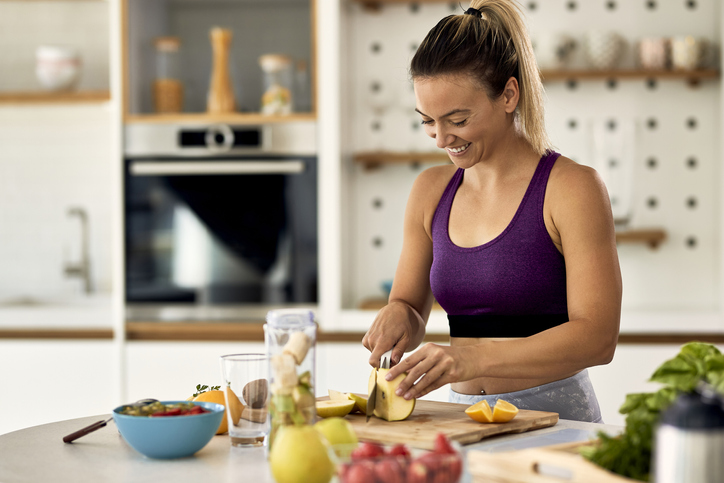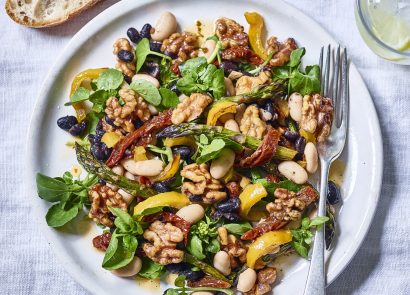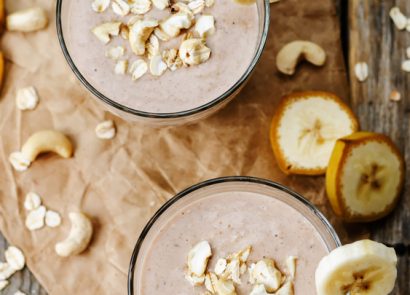We all need food to live, but what we choose to eat can have a huge effect on our overall health. We know that eating a balanced diet is what we should be aiming for, but what exactly does healthy eating look like? How much of each food group should we be eating, and how can a healthy diet help us lose weight? We understand that it can all seem a little overwhelming at first, and it can be hard to begin these healthy eating habits and find the motivation to eat healthy meals. That’s why we’ve created this guide to help you understand why a balanced diet is important, and how to make healthier choices without the hassle.
What is the importance of a balanced diet and healthy eating?
The benefits of healthy eating and a balanced diet are far-reaching, helping you to maintain a healthy weight, good overall health and allowing you to feel your best. A balanced diet, by definition, simply means eating a wide variety of different foods in the right proportions, so that you’re not eating too much, or too little, of each of the five main food groups. If you struggle with portion size when cooking and serving meals, don’t panic. We’ve got you covered with our simple guide to what should be on your plate – for example, did you know that the correct serving of protein is the size of your hand, or that a portion of cheese should be approximately the size of two thumbs?
What is considered a healthy diet?
Let’s get back to basics. What does a healthy balanced diet actually look like? According to the NHS healthy eating guide, which reveals the best healthy foods to eat every day, there are five components of a balanced diet. Here’s a breakdown of what a balanced diet plate should look like so you can start a healthy eating plan.
Fruit and vegetables
Firstly, fruit and vegetables should make up a third of what we eat each day. According to government guidelines for healthy eating and a balanced diet, we should aim for five pieces of fruit and veg per day, whether that’s fresh, frozen, juiced or tinned (although watch out for hidden sugars in tinned options). These foods are important because they are packed with vitamins and minerals that our bodies need to function.
Starchy food
Next up is starchy food, which should also make up just over a third of what we eat. Starchy carbohydrate foods are a good source of energy, as well as a range of other nutrients. This ranges from bread to pasta, but the NHS recommends choosing wholegrain varieties, such as brown bread and pasta, as these will provide you with more soluble fibre than refined grains options. You could also leave skins on potatoes. Fibre is vital for our digestive health, but fewer than one in 10 adults in the UK eat the recommended amount of 30g a day. Luckily, there are lots of ways to increase your intake of fibre, including adding pulses such as lentils and chickpeas to soups and curries, and choosing a high fibre breakfast cereal.
Dairy foods and alternatives
You should aim for two to three servings of dairy products or dairy alternatives per day. This includes milk, cheese, yoghurt, fromage frais, quark and cream cheese, as well as dairy alternatives of these foods – although do watch out for hidden sugars in these options. As well as being good sources of protein and some vitamins, they are an excellent source of calcium, which keeps our bones and teeth strong and healthy. The NHS recommends choosing lower-fat and lower-sugar products where possible. To do this, when you’re doing the food shop, get into the habit of checking the food labels before adding products to your trolley. Most products have nutritional information on the label, and some products also have colour coding on the front, which tells you at a glance if the food has high (red), medium (amber) or low (green) amounts of fat, saturated fat, sugars and salt. The more green(s) on the label, the healthier the choice, so it’s easy to tell if something is right for you.
Beans, pulses, fish, egg, meat and other protein
Many of us base our meals around protein, but actually we should be packing our plates with fruit and vegetables and starchy food first, and then adding protein foods, according to the NHS’s healthy eating plate. Where possible, you should try to choose lean cuts of meat and mince, and eat less red and processed meat, such as bacon, ham and sausages, because these can raise your risk of bowel cancer. It’s recommended that people who eat more than 90g (cooked weight) of red meat per day cut down to 70g for this reason.
When planning your meals, aim for at least two portions of fish every week. One of these should be an oily fish, such as salmon or mackerel, as these are good sources of omega 3, a vital nutrient for brain health. These types of oily fish are also packed with vitamin D, which helps us absorb calcium and therefore keeps our bones and teeth healthy. It also has a role to play in our immune systems. We get most of our vitamin D from sunlight, but during the winter months when we obviously don’t see as much sun, it’s more difficult to obtain, which is why it’s important to up our intake of foods rich in the vitamin, or to take supplements.
If you’re following a balanced vegan diet, you can obtain your protein from pulses, such as beans, peas and lentils. However, you don’t have to eat a plant-based diet to enjoy the benefits of eating these healthy sources of protein – they’re good alternatives to meat because they’re lower in fat and higher in protein, so why not try incorporating Meat-free Mondays into your weekly meal plans? Not only will it be beneficial for you and your family’s health, it’s also good for the environment and can help you save money on your weekly food shop.
Oils and spreads
When you’re cooking, it can be very easy to forget that olive oil you’ve added to your frying pan, or the butter you’ve spread over some bread, meaning that you could end up using too much of these products. It’s important to remember that while some fat is needed in a balanced diet plan (for example, some vitamins require fat to help them dissolve in the body), all fats are high in energy, and therefore should be used sparingly. There are two main types of fats: saturated and unsaturated.
Saturated fat
Saturated fats mainly come from animal sources, such as butter and ghee, lard and suet, although they are also found in palm oil, coconut oil and margarine. These can be harmful as they increase the amount of cholesterol in your blood, which may increase your risk of cardiovascular disease, as well as your risk of having a heart attack or stroke. It’s therefore recommended to reduce your intake of this type of fat. The NHS recommends that an average man should have no more than 30g of saturated fat a day, while an average woman no more than 20g a day.
Another harmful dietary fat is trans fat. Most trans fats are made during the food processing method of partial hydrogenation, and can be found in foods such as microwave popcorn, frozen pizza, fried foods and baked goods, such as cakes and cookies. These too can raise the amount of cholesterol in your blood, and can increase your risk of heart disease.
Unsaturated fat
These types of healthy fats are usually from plant based food sources and can help you to maintain healthy cholesterol levels as part of a healthy diet. You can find them in nut-based oils and spreads, such as almond butter, as well as olive, rapeseed, corn and vegetable oil, and spreads.
Drinks
As humans are 60 percent water, and your blood is 90 percent water, having enough liquid in your diet is vital for many bodily functions. Not only can it lubricate the joints, form saliva and mucus, deliver oxygen around the body and regulate body temperature, but it can also help maintain blood pressure, and it allows vitamins and minerals to dissolve so you can access their benefits. Furthermore, if your skin is dehydrated, it can become more vulnerable to skin disorders and wrinkling, so keeping hydrated is essential for anti-ageing, too.
So how much should we be drinking, and is it only water that is number one? According to the NHS, you should aim to drink at least six to eight glasses of fluid every day as part of a healthy diet, which can include water, milk, tea and coffee, cordials, fruit juice and smoothies and fizzy drinks (making sure to choose sugar-free options). However, during hot weather or while exercising, you may need more than this.
If you’re not a fan of water, remember that you can make it more exciting by adding fruit or vegetables to it (think strawberries or cucumber, for example), or by choosing sparkling water instead of still. You could also try adding fresh mint leaves for extra refreshment.
Fruit juices and smoothies can be a good way of staying more hydrated, particularly for younger children who struggle with drinking enough water. The good news is that they can also count towards your five a day and have a good amount of vitamins and minerals. However, be aware that they can contain a lot of sugar, so ensure you always check the label before buying. Tea and coffee are good but can make you urinate more frequently, so you’ll need to drink more water to stay hydrated. Watch out for lattes, mochas and those that you can buy from coffee shops, as these can contain vast amounts of sugar and fat from additional syrups and cream.
Watch out for your alcohol intake, as it contains a lot of calories and can seriously impact your health if you drink to excess. The government guidelines state that you should limit the amount you drink to no more than 14 units spread evenly throughout the week – remember that different drinks contain varying amounts of units, as well as calories.
Foods high in fat, salt or sugar
As junk food isn’t necessary for a balanced diet, they are known as discretionary foods. These include crisps, chocolate, sweets, cakes, sugary drinks and savoury snacks. You can enjoy them as part of a balanced diet, but only in moderation, as they can lead to issues such as obesity and tooth decay.
Balanced diet and healthy eating ideas
Now that we know what a balanced diet looks like, how can we put that into practice? Here, we show you the best healthy meals to eat for breakfast, lunch and dinner.
Healthy things to eat for breakfast
“Overnight oats are the perfect breakfast solution if you’re always in a rush in the morning, because you can prepare them the night before,” says Rhiannon Lambert, registered nutritionist. “When it comes to your nutrition, oats are a source of soluble and insoluble fibre and protein, helping to keep you feeling full, satisfied and providing slow-releasing energy for the day ahead. There are so many variants to overnight oats, so you won’t get bored of them, plus you can pair them with some fruit for added nourishment. I like to include a sprinkling of flaxseed in mine, combined with some berries and topped off with almond butter.”
Smoothies are a great introduction to breakfast if you don’t like to consume a lot of food in the morning, as they’re light and quick to make. “Smoothies are a great way to get some extra fruit into your diet if you don’t snack on any throughout the day,” says dietitian Sophie Medlin. “This breakfast smoothie will give you a boost of fats and slow-release carbohydrates thanks to the fruit and the oats, making it ideal for people who are very active in the morning. This recipe also offers lots of plant compounds, such as antioxidants and polyphenols, which are associated with better health when we eat them regularly. For a better balance, you could add some extra protein from soya or cows’ milk rather than almond milk or, better still, some yoghurt. Add some kale or spinach to give some additional nutrients.”
Healthy lunch ideas
Healthy eating recipes for a balanced diet require the three macronutrients (protein, fats and carbohydrates) to promote muscle growth and harness energy. “Start off by choosing a form of protein, whether that be meat, fish or a vegetarian alternative, and then build your lunch around it,” explains Vanessa Gebhardt, qualified nutritionist for Freeletics. “By focusing on high-quality protein first and then adding vegetables and carbs around that, you get a perfect meal structure.” head of Healthspan Nutrition, Rob Hobson, agrees, adding that once you’ve built your bowl around the key food groups, you can focus on the taste. “There are so many interesting ways to flavour food, and herbs and spices are a good place to start, as they also add extra nutrition in the form of minerals and antioxidant compounds. Citrus juices and dried fruit are always a good addition and work well in savoury foods, such as tagines, stews and salads.”
Healthy snacks to eat for a balanced diet
Swapping a bag of crisps for some crudités, such as carrots, cucumbers and peppers with hummus is a simple way to pack in some more veg to your day. Prepare enough for a few days so that you can quickly grab them from the fridge when you feel hungry. If you’re not a fan of hummus, you could cut up an apple and dip it in peanut butter for a protein hit. However, if a packet of crisps is what you or your kids are craving, you could make your own vegetable crisps by thinly slicing vegetables, such as sweet potatoes, parsnips and carrots, cooking them in the oven and then seasoning them – try sea salt, black pepper or chilli flakes. They’re sure to satisfy even the pickiest of eaters!
Eating healthily on a budget
In the UK, we spend an average of £60.60 on a family food shop every week, and this figure is likely to go up as food prices continue to soar. With average household spending also on the rise, it’s enough to get us all worrying about our bank balances. Luckily, there are some clever ways that you can reduce your supermarket checkout bill without making too many changes to your overall lifestyle – we’ve called in the experts to show us how.
Plan your food shop
“It’s easy to pile up the trolley with food we think we may use, or get tempted by extras that we don’t need at all,” says weight loss consultant Dr Sally Norton. “We overdo it, and then throw lots away – in fact, we waste almost 200kg of food, per person, every year. Instead, spend time planning your healthier meals and buy exactly what you need. You could even purchase food online to avoid added temptation. Or, make sure you fill up on a healthy snack before you shop, to avoid buying more than you need.”
Buy in bulk
“I tend to buy things like oats, rice and whole wheat pasta in larger quantities,” says Aine Carlin, author of plant-based cookery books. “Basics like these add texture with nuts and seeds. This is also a great way to ensure your meals are satisfying. Making big batches of overnight oats, pasta or rice salad is not only a useful time-saver, but is easy on the pocket, too. Boost your dishes with a variety of seasonal fresh fruit or veg.”
Alternate your proteins
“Bulk out your meals with pulses and beans such as tinned chickpeas, lentils and cannellini beans – all of which you can buy canned,” says dietitian Harriet Smith. “You don’t need to cut out meat entirely when eating on a budget. A packet of mince, for example, can stretch to several meals, if you bulk it out with cheaper and wholesome ingredients, such as vegetables and pulses – try using 50 percent meat and 50 percent veg.”
Create a healthy eating meal plan for a balanced diet
“Making multiple meals every evening can be costly and stressful,” adds Aine. “Why not compromise by having everyone’s favourite dish on selected days? Taco Tuesdays are always fun and allow you to be flexible with ingredients. Cauliflower is perennially affordable and super when broken into florets, coated in spices and roasted. Load it into soft flour tortillas, along with fresh rocket, avocado and a dollop of crème fraiche, for a seriously moreish dinner.”
Use versatile vegetables
“Don’t underestimate the humble potato,” says Harriet. “This cheap and versatile vegetable is a good source of vitamin C – a large potato can provide as much as half of your vitamin C intake – plus potassium and starchy carbs for energy. Top it with some tinned fish, mixed with natural yoghurt or mayonnaise and serve with salad. Or, you could serve it with baked beans, which is a good source of plant-based protein and fibre, topped with calcium-rich grated cheese for a nutritious and filling meal.”
Shop local
“Steer clear of the supermarket with its aisles of expensive, processed food and head to your local butcher, fishmonger or green grocer,” advises Dr Sally. “You can buy what’s in season, locally sourced, in the quantity you need and without all the packaging. Plus, it’s often a fraction of the price. If you become a regular, you may be able to pick up older veg and meat bones for free – these are great for making hearty and healthy soups and stews.”
Choose frozen fruit and vegetables
“Fresh isn’t always best,” explains Harriet. “Frozen, tinned and juiced fruits and vegetables are often much cheaper than their fresh equivalents. Plus, there are some studies suggesting that frozen fruits and vegetables are more nutritious as they are frozen at the point of purchase, therefore retaining more of their vitamins and minerals.”
Cook from scratch for a balanced diet
“Not only can you control what goes into your food and avoid the salt, sugar, bad fats and chemicals that make up much of the pre-prepared food on offer in the shops, cooking from scratch is also a much cheaper way to eat, as you aren’t paying for production and packing costs,” says Dr Sally. “And, with a little imagination and planning, leftovers can be made to last for a further meal or two. Until you try, you won’t believe how easy it is to make your own bread, yoghurt, soups, smoothies and much more.”
Make use of your freezer
“Freeze bread and pop a slice into the toaster as and when you need it,” advises Harriet. “This prevents your loaf from going mouldy and being thrown out as food waste.”
Grow your own vegetables and herbs
“OK, so you can’t get the full range of fruit and veg that you find in a supermarket, but it’s better to eat seasonally and avoid the carbon footprint of a pineapple flown in from Costa Rica,” says Dr Sally. “Even a window box can produce some decent herbs to flavour salads and omelettes; a tub can be used for carrots, salad leaves or beetroot; and a hanging basket can produce a great crop of cherry tomatoes. An allotment can be used to grow a whole lot more, as well as helping you get some valuable exercise!” Want more ideas on growing your own produce? Visit Grow Your Own for tonnes of advice and suggestions.





















